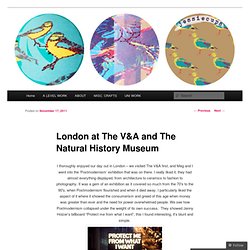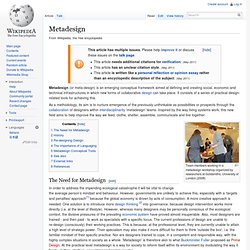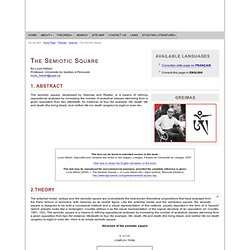

DISCURSO, SEMIÓTICA, INTERTEXTO Y otras fiebres contemporáneas. Top Car Designers Critique Google's Self-Driving Car. Google's self-driving car isn't just unconventional in the fact that it drives itself: it's an extremely unusual design, more reminiscent of micro-cars like the Smart Car, Fiat 500, and that weird BMW that Steve Urkel drove than a conventional auto.

From the bulbous shape to the total lack of manual controls to the literal smiley face on the car's face, the Google car isn't quite like anything else on the road. So we got curious: what do car designers think of it? Most active designers chose not to speak to us, not wanting to comment on what might be a competitor in the near future, but we tracked down three of the best designers in the business--or formerly in the business--showed them Google's demo video and asked for their thoughts.
Snarkitecture-Designed Beats Headphones Hint At What The Apple Era Could Look Like. Snarkitecture, a collaborative art/design studio that mostly works with slightly skewed, broken-looking furniture and apparel, teamed up with Beats by Dre to create a special, limited-edition pair of Beats headphones.

And not only do they look cool, they are all the more relevant now that Apple has purchased Beats. The Beats x Snarkitecture headphones, a riff on the Beats Studio line, are pure white. "By stripping away the familiar colors and logos," says Snarkitecture, "the headphones are reduced to their purest form. " (That still includes the lowercase B on the outside of the cups, because it is engraved into the plastic itself rather than painted on.)
London at The V&A and The Natural History Museum. I thoroughly enjoyed our day out in London – we visited The V&A first, and Meg and I went into the ‘Postmodernism’ exhibition that was on there.

I really liked it, they had almost everything displayed, from architecture to ceramics to fashion to photography. It was a gem of an exhibition as it covered so much from the 70′s to the 90′s, when Postmodernism flourished and when it died away. I particularly liked the aspect of it where it showed the consumerism and greed of this age when money was greater than ever and the need for power overwhelmed people. We see how Postmodernism collapsed under the weight of its own success. 23 Clever Urban Hacks Made From Trash On New York City Streets. Over the last three years, an anonymous artist has wandered around the streets of New York finding random pieces of trash and turning them into something useful.

A scrap of wood, tucked into the curve of a U-shaped bike rack, became a temporary folding chair. Bottle holders from abandoned bikes, attached to the sides of a trashcan, transformed into mini-recycling bins. An old ball tied to a signpost became a game. In total, the artist has created 23 of these interventions so far in a project called Rotten Apple. “I was walking around and seeing people really checked out in the city on their commutes, and this was a way to activate those spaces and have them engaged a little more,” the artist told Co.Exist.
Some of the ideas are playful, like a magnetic poetry set used to spell out the lyrics to "(You Gotta) Fight for Your Right (to Party!) " "They're provocations, addressing the latency in the urban environment," he says. Vladímir Propp. Vladímir Yákovlevich Propp (en ruso, Владимир Яковлевич Пропп; San Petersburgo, 29 de abril de 1895-Leningrado, 22 de agosto de 1970) fue un antropólogo y lingüista ruso dedicado al análisis de los componentes básicos de los cuentos populares rusos para identificar sus elementos narrativos irreducibles más simples.

Trabajo[editar] Su Morfología del cuento (Morfológuiya skazki)[1] fue publicada en ruso en 1928; aunque influyó a Claude Lévi-Strauss y Roland Barthes, fue prácticamente ignorada en Occidente hasta que fue traducida al inglés en el año 1958. Analizó los cuentos populares hasta que encontró una serie de puntos recurrentes que creaban una estructura constante en todas estas narraciones. Es lo que se conoce como "Las funciones de Vladímir Propp". Son una serie de treinta y un puntos recurrentes en todos los cuentos de hadas populares. La teoría de Propp se basa en un análisis estructural de la morfología de los cuentos, donde parte del corpus para llegar a la clasificación. Armando Silva - Imaginarios Urbanos.
Armando Silva Téllez. Armando Silva (Bogotá, 19 de agosto de 1948) es un filósofo y semiólogo colombiano, más conocido por su trabajo de los “Imaginarios Urbanos” desarrollado en varias ciudades de América Latina y España.[1] Biografía[editar]

The Best Eye Candy From Milan Design Week. Carré sémiotique. Un article de Wikipédia, l'encyclopédie libre.

Le carré sémiotique, proposé par le linguiste et sémioticien lituanien Algirdas Julien Greimas, est un outil servant à formaliser les relations entre des signes sémiotiques et à représenter l'émergence de la signification à l'intérieur d'une structure. Il serait dérivé dans une certaine mesure du carré logique d'Aristote. Description[modifier | modifier le code] Metadesign. Metadesign (or meta-design) is an emerging conceptual framework aimed at defining and creating social, economic and technical infrastructures in which new forms of collaborative design can take place.

Productoverview. Design theory as analysis of a product languagedesign theory and practice: morphology, semiotics. Many attempts have been made to formulate a comprehensive theory of design, but as far as I know most of them are rather of a more methodological character.

Buerdek in his famous book (1)distinguishes between design methodology and design theory, the first centered on methods of structuration of design problems and processes of problem solving, the second regarding the more general topic of laying the foundation of a scientific frame of design philosophy. Algirdas Julien Greimas : The Semiotic Square / Signo. Greimas The semiotic square, developed by Greimas and Rastier, is a means of refining oppositional analyses by increasing the number of analytical classes stemming from a given opposition from two (life/death, for instance) to four (for example, life, death, life and death (the living dead), and neither life nor death (angels)) to eight or even ten.

This text can be found in extended version in this book: Louis Hébert, Dispositifs pour l'analyse des textes et des images, Limoges, Presses de l'Université de Limoges, 2007. Click here to obtain the English translation of this book. This text may be reproduced for non-commercial purposes, provided the complete reference is given: Louis Hébert (2006), « The Semiotic Square », in Louis Hébert (dir.), Signo [online], Rimouski (Quebec), The actantial model, isotopy and the semiotic square are undoubtedly the best-known theoretical propositions that have emerged from the Paris School of semiotics, with Greimas as its central figure.